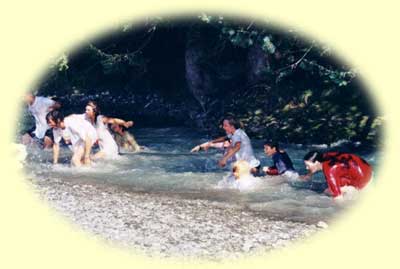The most important stages in the history of the Likatier tribe can be summarized chronologically as
follows:
1969: Foundation of PFA (Planet For Absolution), the predecessor organization of the tribe, on the
initiative of Wolfgang Wankmiller with five founding members (Wolfgang W., Bernhard K., Walter K., Wilhelm S.
and Wolfgang Sch.).
1969: Foundation of a PFA library and a PFA music archive.
1973: First public PFA dance event (parties) for young people in the youth centre in Füssen.
1974: Foundation of the Likatier tribe at Luitpoldstrasse 8 in Füssen.
1974: Tribal founder Wolfgang Wankmiller ends his school and since then devotes himself exclusively
to the development of the tribe.
1974: Rental of the first apartment for the tribe.
1977: Birth
of the first child
within the tribe.
1977: Various tribal members begin to become massively politically involved in various parties and
pursue the goal of helping a policy of environmental and homeland protection and greater proximity
to citizens to achieve a breakthrough. Politics became the tribe's main commitment for several
years.
1981: The first property comes into the possession of the tribe.
1982: Introduction of the tribal calendar with its own New Year and counting of
years.
1982: The Reinigungsfest
(tribal foundation festival) is celebrated for the first time.
|
|
Start of the first major media campaign against the tribe, triggered by the CSU district chairman
Richard Wengenmeier (Bavarian state parliament representative).
1982: Foundation of the first tribal company.
1983: Tribal women usually begin to give birth to their children at home.
1984: Tribal founder Wolfgang Wankmiller runs for the office of district administrator of the
Ostallgäu district and receives about 9% of the votes.
1984: The first tribal member comes to the Ostallgäu district council.
1985: Foundation of the five social
groups within the tribe.
1990: The tribe ends its political commitment in its present form.
1990: The tribe shifts its top employment priority away from politics towards the
establishment of businesses and the development
of tribal culture.
1991: The tribe comes into possession of the first agricultural land.
1991: Beginning of ancestor research
in the tribe and the development of an own ancestral
culture.
1991: Establishment of seven tribal
divisions
as an economic division of the tribe and dissolution of the "Team" as the previous economic
management body of the tribe.
1993: Most tribal members change their diet to ovo-lacto-vegetarianism.
1993: The tribe, which up to now simply called itself the "Stamm" (german word for tribe),
gives itself the name "Stamm Füssen
Eins" (tribe füssen one) and expresses with the "One" that it wishes that there are many other New Tribes in Füssen and in the
World at large besides it.
|
|
1993: The tribe introduces itself as a tribe to the public for the first time.
1993: The tribe as a whole is visited by a guest
for the first time.
1994: The tribe recognizes matriarchy
as the most human-like form of community and decides to develop in this direction.
1994: For the first time, the tribe makes contact with other communities and begins to build friendships with
numerous communities around the world. Welt aufzubauen.
1994: Start of the second major media campaign against the tribe.
1995: The first tribal
women begin to breastfeed their children until the children stop
breastfeeding themselves.
1996: The 100th member
(Lebemensch) joins the tribe.
1996: Introduction of a comprehensive tribal time system with its own terminology for
weekdays and months, as well as its own month count and start of the day.
1996: Some tribal members discover the Mother-Goddess as a spiritual
phenomenon and establish a corresponding spiritual
culture.
|
|
1997: Creation of the likatic tribal organography, as a collection of decisions on the structure and
organs of the tribe.
1997: Introduction of tribal names.
1997: Foundation of the tribal circles as
different types of membership.
1997: Foundation of the tribal kin.
1997: Foundation of the Council of Elders.
1997: Creation of the first tribal coat of arms.
1998: The "Stamm Füssen Eins", partly also called
"Stamm Füssen" gives itself a new name: "Stamm
der Likatier" (tribe of the Likatier) and calls its habitat "Likatien".
1999: The first likatic children come to home schooling.
2000: Start of the third major media campaign against the tribe.
2000: Introduction of the day names, where each day of the year has its own name.
2000: Introduction of the name days
for the tribal members.
2000: The 500th Lamatiede is celebrated in
a big party.
2000: Beginning of the Interspecies-activity and friendship of the tribe with the whales and dolphins.
2000: Beginning of friendship between the Likatier and Hopi tribes as an exemplary relationship between a New Tribe and a traditional tribe.
2002: For the first time the lech games
are carried out.

2002: A big party celebrates the 600th
Lamatiede.
2002: The 150th
member (Lebemensch) joins the tribe.
2003: The tribe becomes a member of the Global Ecovillage Network (GEN).
2003: The Likatier tribe organizes for the first time together with other New Tribes
a large summer camp of the New Tribes.
2003: The tribe introduces itself for the first time publicly on the Internet with its own homepage.
back to the top of the page



